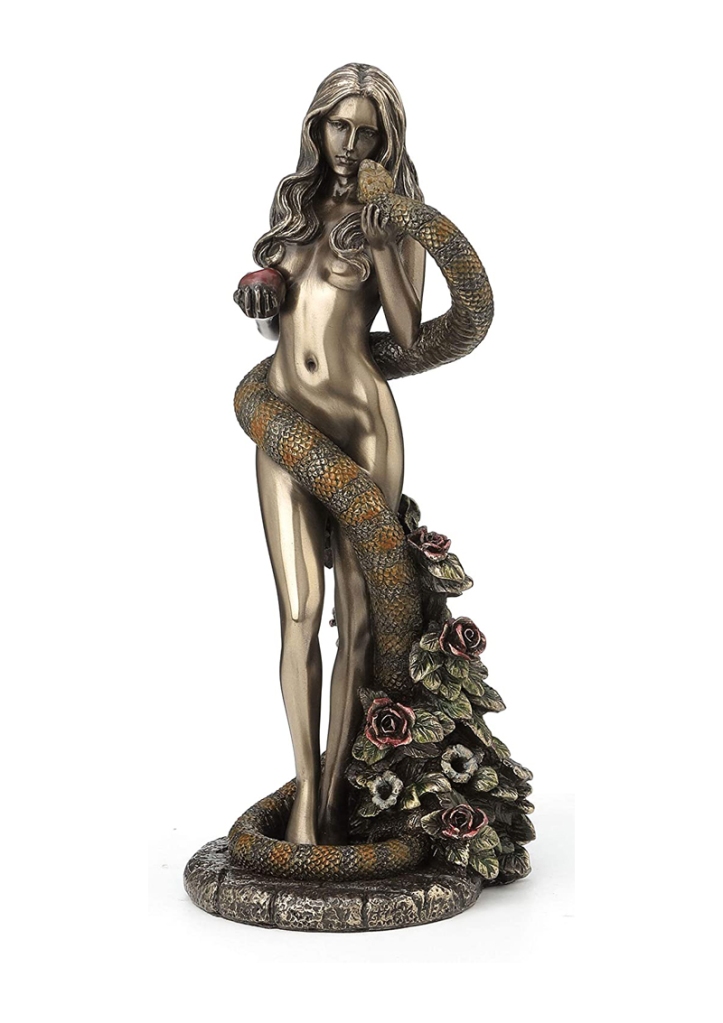Eve Holding Apple with Coiling Serpent Statue
This Eve with Coiling Serpent Statue is beautifully created in cold cast bronze, a process of mixing bronze powder with resin giving it a stunning solid metal appearance. Hand detailed with red and green colored accents giving to Eve and to the Serpent a visually exciting look. Depicts a bare Eve as she contemplates eating the forbidden fruit and being led astray by the serpent as it coils around her, enticing her to take a bite. You will not certainly die, says the serpent, but Eve knows to be wary the temptation of the forbidden fruit. Designed by world-famous artist James Ryman, this attractive statue depicts a bare Eve, standing in the garden, holding a red apple in her hand as the serpent coils itself up her body, enticing her to eat it, whispering temptations as she gazes into its eyes. Serpents are referred to in both the Hebrew Bible and the Christian New Testament. The symbol of a serpent or snake played important roles in religious and cultural life of ancient Egypt, Canaan, Mesopotamia and Greece. The serpent was a symbol of evil power and chaos from the underworld as well as a symbol of fertility, life and healing. Nāhāš, Hebrew for “snake“, is also associated with divination, including the verb form meaning “to practice divination or fortune-telling“.
Nāhāš occurs in the Torah to identify the serpent in the Garden of Eden. Throughout the Hebrew Bible, it is also used in conjunction with Seraph to describe vicious serpents in the wilderness. The Tannin, a dragon monster, also occurs throughout the Hebrew Bible. In the Book of Exodus, the staves of Moses and Aaron are turned into serpents, a Nāhāš for Moses, a Tannin for Aaron. In the New Testament, the Book of Revelation makes use of ancient serpent and the Dragon several times to identify Satan or the Devil (Rev 12:9; 20:2). The serpent is most often identified with the hubristic Satan, and sometimes with Lilith. The story of the Garden of Eden and the fall of man represents a tradition among the Abrahamic religions, with a presentation more or less symbolical of certain moral and religious truths. In the Hebrew Bible, the Book of Genesis refers to a serpent who triggered the expulsion of Adam and Eve from the Garden in Eden (Gen 3:1-20). Serpent is also used to describe sea monsters. Examples of these identifications are in the Book of Isaiah where a reference is made to a serpent-like dragon named Leviathan (Isaiah 27:1), and in the Book of Amos where a serpent resides at the bottom of the sea (Amos 9:3).
Serpent figuratively describes biblical places such as Egypt (Jer 46:22), and the City of Dan (Gen 49:17). The prophet Jeremiah also compares the King of Babylon to a serpent (Jer 51:34). Serpent occurs in the Book of Revelation as the “ancient serpent” or “old serpent” used to describe “the dragon“, Satan the Adversary, who is the devil. This serpent is depicted as a red 7-headed dragon having 10 horns, each housed with a diadem. The Serpent battles Michael the Archangel in a War in Heaven which results in this devil being cast out to the earth. While on earth, he pursues the Woman of the Apocalypse. Unable to obtain her, he wages war with the rest of her seed (Revelation 12:1-18). He who has the key to the abyss and a great chain over his hand, binds the serpent for a thousand years. The serpent is then cast into the abyss and sealed within until he is released (Revelation 20:1-3). In Christian tradition, the “ancient serpent” is commonly identified with the Genesis Serpent and as Satan. This identification redefined the Hebrew Bible’s concept of Satan (“the Adversary“, a member of the Heavenly Court acting on behalf of God to test Job’s faith), so that Satan/Serpent became a part of a divine plan stretching from Creation to Christ and the Second Coming. Eve Holding Apple with Coiling Serpent Statue sizes: 3.5 inches / 9 cm x 3 inches / 7.5 cm x 8 inches / 20 cm.
Eve with Coiling Serpent Statue on Amazon.
Eve with Coiling Serpent Statue on eBay.
Symbolic Statues, Religious Statues and Christianity Statues.



